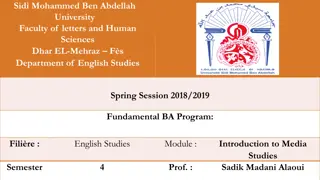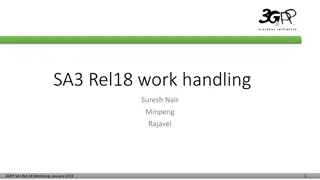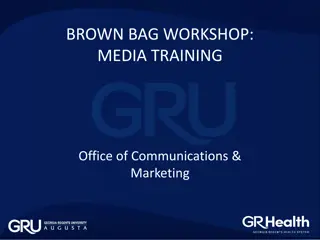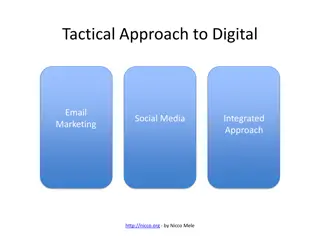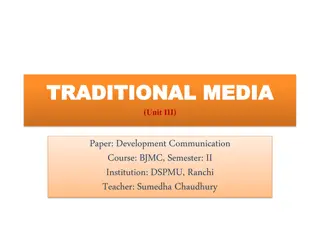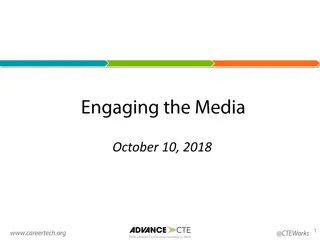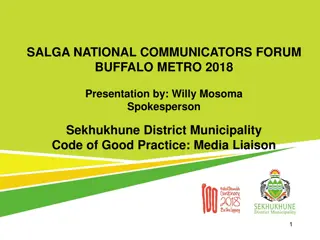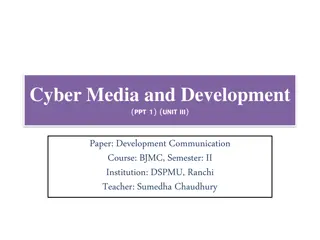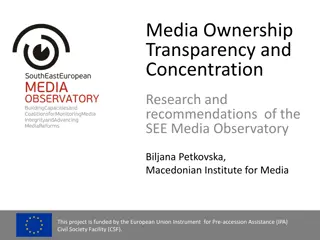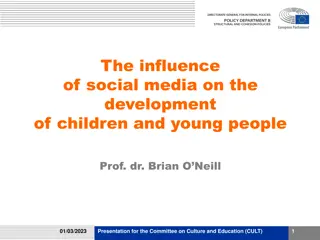
Role of Media in National Development
Explore the significant role of media in stimulating national debate, creating demand for change, and contributing to the development of societies. Discover how media can be part of national information strategies to provide communities with essential services. Learn about strengthening media in developing countries for a more effective role in development.
Download Presentation

Please find below an Image/Link to download the presentation.
The content on the website is provided AS IS for your information and personal use only. It may not be sold, licensed, or shared on other websites without obtaining consent from the author. If you encounter any issues during the download, it is possible that the publisher has removed the file from their server.
You are allowed to download the files provided on this website for personal or commercial use, subject to the condition that they are used lawfully. All files are the property of their respective owners.
The content on the website is provided AS IS for your information and personal use only. It may not be sold, licensed, or shared on other websites without obtaining consent from the author.
E N D
Presentation Transcript
Media & National Development Policy Dr. Ibrahim Saleh Image by James Emiry
"Knowledge has been at the heart of economic growth and the gradual rise in levels of social well-being since time immemorial. The ability to invent and innovate, that is to create new knowledge and new ideas that are then embodied in products, processes and organizations, has always served to fuel development". (David & Foray, 2002) Image by Rusty Sheriff
Values at the heart of change Images sourced from: http://www.humanosphere.org
Media and Development Cultural diversity - plurality in all social spheres of activity. Governance for inclusion and poverty reduction. Education contributing to well-being and choice. Dignity, equal and inalienable rights & entitlements. Participatory media what does this really mean?
Media and Democratization Models Media as distribution channels Media as actors and agents Agenda setting Framing Supportive or critical
Media as agent of change What is the role of the media in stimulating national debate and creating a demand for change? How can media form part of national information strategies? (provide communities with health, livelihoods and education) How should the media in developing countries be strengthened to enable it to play a more effective role?
Media research Media & Professional Education Media & Governance Media & Cultural Diversity Human Rights, Media and Communication Access and Literacy Participatory Media and Communication Representation by Media Strategic Media Policies and Action Plans Monitoring Media for Development
How to Measure Media and development? Formative research to identify the parameters of viable media interventions Qualitative research methods to pre-test media and communication materials Continuous feedback research to monitor the audience reception to media outputs Audience-based qualitative and quantitative methods to measure reach and impact of media interventions
Research and Evaluation Cycle Impact Evaluation: Quantitative Surveys and Qualitative Studies Surveys, Skills Assessment, Pre/Post Tests, Indices Knowledge, Attitude, Practices/Behaviours Baseline Barriers, Facilitators Midline Refine Objectives Tracking Set Priorities Stages of Change Identify, Profile Target EndlineAudiences, Partners, Participants Content Analysis, Pre/Post Tests Follow Up Interviews, Policy Analysis Journalistic Principles Scenario Exercises Professional Norms, Standards Statistical Analysis Trends Relationships between Exposure and Outcomes Formative Pilots Pre-Testing Mechanisms of Effectiveness Audience Feedback Primary & Secondary Data Focus Groups Community- Based Rapid Feedback In-Depth Interviews Letters, Texts, Follow-Up Studies, Panels, Contests Focus Groups, in- Depth Interviews, Statistical Analysis Intensity of Exposure Combinations of Outputs, Multiple Platforms Use of Animation Humour How Audience Relates to characters Branding Predispositions Profiling Shared, Associated Attributes Values, Tastes Habits, Rationales Context Epidemiological, Behavioural Situation, Context Analysis Media Consumption Ethnography Reactions Interpretation Message Delivery Viewing/ Listening Context Characters, Presenters Story Lines Update / Reformat Extension New Developments Formats Content Scripts Characters Attributes Production Quality Branding Message Clarity Accurate Targeting Cultural Suitability
Whats our No. 1 Problem? Aids? Digital divide? Corruption? Women/child abuse? War and strife? Fundamentalism? Despotism?
However, it all depends how we look at it but in any problem, we need value- driven journalism work in order to tackle it.
Poverty Form of deprivation Deprivation of what? From whose perspective? These influence measurement approaches Common definitions are: Inability to meet basic necessities of life money- metric measures; Failure of some capabilities -lack of opportunities and choices to lead a dignified life "capabilities" & "functioning" approach Inability to participate in one s community: Social exclusion
Transient poverty Poverty is dynamic - nature & characteristics change over time Movements poverty resulting from shocks such droughts, floods, pests infestation of crops, etc. Understanding factors contributing to Poverty Helps develop interventions linked specific risks Lack of data poses a challenge Measuring impacts of shocks on livelihoods using participatory approaches
South Africa Human Development Report focuses on provision of public services: introduces service deprivation index (SDI) Indicators-housing type, energy type (for cooking, heating & lighting), water, sanitation & refuse removal. SDI measures the distribution of progress in reducing deprivation in basic services Limitation shaped around commodity evaluation
Social Exclusion Intended to capture structural features of poverty. Inability to participate in ones community Exclusion from political, cultural & economic processes Human poverty-location specific Nature of deprivation vary with social & economic conditions
Key Questions: 1. Why Poverty is Public Enemy no. 1 2. The journalism of poverty 3. The poverty of journalism 4. What s to be done?
whose problem it is the poor? government? civil society? business? individuals? media?
Poverty reflects deep structural problems within societies. Media isn t a solution, but perhaps the way it is practiced is a part of the problem? Let s be realistic: the media can t end poverty. But if we in journalism don t cover it intelligently (with attachment and outrage) the media will be an obstacle in poverty alleviation.
Media Challenges to report poverty Hard to link the different aspects: In SA, the one- dimensional focus is more common than the multidimensional one. The reporting on one angle, more-or-less in isolation of others, are in land and housing/homeless stories (Burger, 2007). Poverty is often hidden under other frames crime, gender, Aids, strikes, unemployment. But poverty coverage often hides aspects like gender, and power. The challenge is to cover a condition with many causes
Journalism of poverty: Charity angle Dichotomy: Stories of people who are poor Stories of "poverty" (often policy promises) Reports of manifestations of poverty, do not ID these "exhibits" as constituting "poverty". Yet, linkage is necessary to grasp poverty as a generalised condition with inter-dependent and mutually reinforcing dimensions.
Journalism of poverty: political spectacle Examples President promises relief Opposition accuses President of neglect. Little independent follow-up. Glorification of the correspondent Sympathy is created with the journalist, not poor people
Who should address poverty? Solving poverty seldom painted as some-thing where all stakeholders play a part: - poor people (they are not "objects" to be pitied and uplifted through pure charity), - government (elected bodies supposed to deal with it), - civil society (NGO's, scholars, students, churches, etc.), - employers/business/educational institutions, - individuals.
References Burger, D. (ed). 2007. South African Year Book 2006/2007. Pretoria: Government Communication and Information System. http://www.gcis.gov.za/content/resource-centre/sa- info/yearbook/2006-07 David, P.A. & Foray, D. 2002. An introduction to the economy of the knowledge society. International Social Science Journal. 54(171):9-23. http://onlinelibrary.wiley.com/doi/10.1111/issj.2002.54.issue- 171/issuetoc






